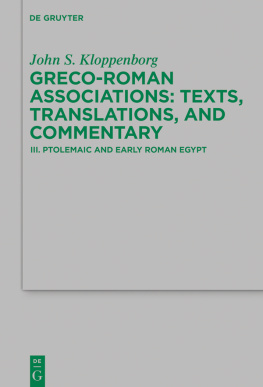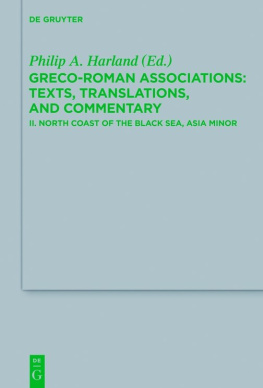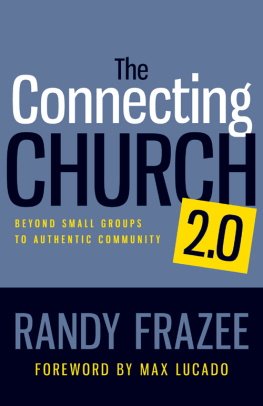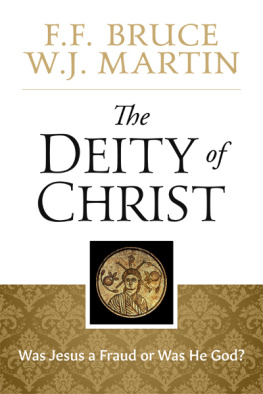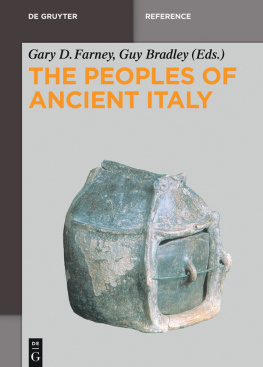CHRISTS ASSOCIATIONS
CHRISTS ASSOCIATIONS
Connecting and Belonging in the Ancient City
John S. Kloppenborg
Yale UNIVERSITY PRESS
New Haven and London
Published with assistance from the Mary Cady Tew Memorial Fund.
Copyright 2019 by Yale University.
All rights reserved.
This book may not be reproduced, in whole or in part, including illustrations, in any form (beyond that copying permitted by Sections 107 and 108 of the U.S. Copyright Law and except by reviewers for the public press), without written permission from the publishers.
Yale University Press books may be purchased in quantity for educational, business, or promotional use. For information, please e-mail (U.K. office).
Set in PostScript Electra type by Newgen North America, Austin, Texas.
Printed in the United States of America.
Library of Congress Control Number: 2019936636
ISBN 978-0-300-21704-9 (hardcover : alk. paper)
A catalogue record for this book is available from the British Library.
This paper meets the requirements of ANSI/NISO Z39.48-1992 (Permanence of Paper).
10 9 8 7 6 5 4 3 2 1
To M.
in gratitude
CONTENTS
PREFACE
More than thirty years ago, in The First Urban Christians, Wayne Meeks struck a new note in the study of early Christ assemblies, focusing attention on devotees of Christ as residents in the major cities of the Roman Empire. This brought an engagement with what I call the materiality of the early Christ cultthe demographics of the Jesus movement, the main social and economic catchments of its members, models of governance, and the practices in which Christ followers engaged, including water rituals, communal meals, and collection of funds. Only in his last chapter did Meeks engage with what up to that point had been the major preoccupation of the study of the Jesus movement: its beliefs and confessions.
Since Meeks wrote his book we know much more about the associative practices of other small, face-to-face groups in Greek and Roman antiquity. These associations organized around the workplace, the cult of a deity, a diasporic identity, an extended family, or a neighborhood and could be found in practically every city and town of the Mediterranean. For the nonelite population, associations were the principal context for social, cultic, and other forms of interaction beyond the family on one hand and the citizen assembly in free Greek cities on the other.
Data about these groups have never been employed systematically and carefully as comparanda for early Christ assemblies, although since the late nineteenth century there have been a few gestures in this direction. While knowledge about Greek and Roman associations does not in itself produce any new data about Christ groups, comparison offers two benefits. First, since much is known about a variety of features and practices of those groups that is not known about Christ groupsmembership size and profile, recruitment practices, governance, finances, and the relation to the cities in which they were residentwe can use data from associations heuristically to raise questions about Christ assemblies: What options were available for monitoring membership? Were membership lists kept, as they were in most other associations? When early texts speak of someone leaving a group or being expelled, what concretely is imagined? How were meals financed? In Christ assemblies that included elite or subelite individuals, how do we imagine their relationships to others in the group? Why do Christ groups imitate political language, calling the group an ekklsia, the standard Greek term for a citizen assembly, or addressing Jesus as kyrios and speaking of his parousia? The use of comparanda from the rich data set supplied from associations allows the scholar to ask questions that hitherto have not been asked about Christ groups and to at least sketch the parameters of answers to these questions.
A second benefit of careful comparison is the ability to set some boundaries to our imagination of what was possible and likely for Christ assemblies. If the mean membership size of Greek and Roman cultic associations was about thirty people, how much larger can we reasonably imagine Christ groups to have been? What models are attested for financing the communal meals of associations, and how then might we reconstruct the financing of Christ groups? Having knowledge of the practices of other small face-to-face associations allows us to move from speculative scenarios about what might have been the case to documented possibilities. This is a matter of normalizing our reconstructions of the earliest Christ assembliesthat is, treating them as phenomena that belong to the spectrum of social practices of the ancient Mediterranean instead of exoticizing them as something unparalleled, incomparable, and sui generis.
Some readers will find this book irritating, for at least three reasons. First, in contrast to many works on the earliest Christ assemblies, I emphasize the ways in which Christ assemblies were comparable with other small face-to-face groups. The habit of much scholarship has been to dramatize the extent to which Christ assemblies (and Judean assemblies) were unique. Anxiety over identity is only heightened when pagan analogies are adduced. Hence, some readers may be distressed to learn that these assemblies were not as unusual, either demographically or in terms of their practices, as is often supposed.
It is not that I claim that Christ assemblies were just like other associations. That would be silly. Guilds and associations were extremely diverse, with hardly two of them exactly alike. But the claim that Christ groups were incomparable and incommensurable is not only historically untrue, it probably disguises a theological rather than a historical presumption that Christ devotees must have been up to something that was completely new and unparalleled and ultimately the result of divine causality. There are indeed some very interesting innovations of Christ assemblies and ways that their practices stood out from the practices of other comparable groups. The benefit of careful comparison that identifies similarities is that it in fact allows the differences to stand out with special prominence. But to ignore similarities and exaggerate differences obscures the many ways that Christ assemblies were also like other groups. It risks turning historiography into apologetics.
Second, it is common to insist that the most proximate comparandasometimes the only salient onesfor early Christ groups are Judean synagogues and their practices, from which Christ groups derived most of their practices and beliefs. This, as Jonathan Z. Smith observed in Drudgery Divine, is often a strategy to isolate the early Christ cult from its Greco-Roman environment, from which is was supposedly overwhelmingly different. But then it is claimed that early Christ groups swiftly outstripped their Judean roots or even consciously distinguished themselves from those roots. Hence, in two swift moves the Christ cult becomes sui generis.
This too is apologetics, not historiography. I will avoid this approach, not because Judean synagogues were not important in the world in which Christ groups operated. Various iterations of the Christ cult owed much to Judean synagogues. The letter of James, for example, calls its meeting a synagg, a common term used by Judean assemblies, and it reflects a version of the Christ cult that saw itself as fully embedded in diasporic Judaism. Pauls identity as a diasporic Judean and his frequent interactions with other Judeans meant that the shape of his thought is influenced by Judean conceptual frameworks. Others still, such as the author of the letter to the Hebrews, invoked models of priesthood and sacrifice from the Hebrew Bible in order to advance the claim that a more perfect form of priesthood and sacrifice had appeared in Christ. Meanwhile, the author of the Letter of Barnabas constructed much of his letter around the thesis that the true meaning of the Hebrew Bible had been misunderstood by Judeans and was available only to Christ followers. Thus, the Hebrew Bible and Judaism loom large in the construction and self-understanding of Christ assemblies.
Next page

